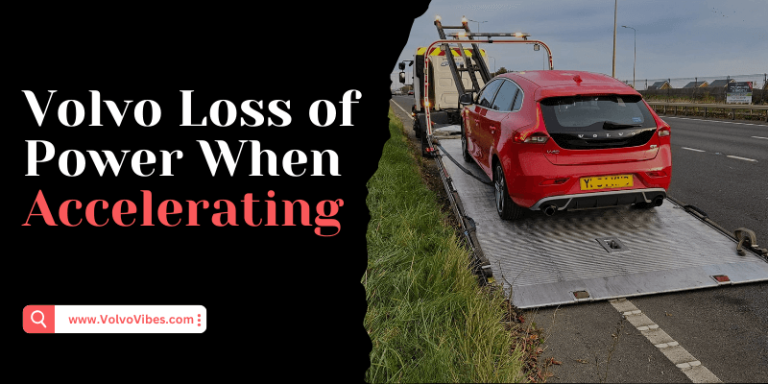Experiencing a loss of power when accelerating in your Volvo can be frustrating. This issue affects many Volvo owners and can have various causes.
A sudden drop in power can make driving stressful and even dangerous. It disrupts your daily routine and raises concerns about repair costs. Understanding the possible reasons behind this problem can help you address it effectively. In this blog post, we will explore common causes and solutions for Volvo’s loss of power during acceleration.
By identifying the root of the issue, you can restore your car’s performance and enjoy a smoother driving experience. Stay tuned to learn more about diagnosing and fixing this common problem.

Credit: volvovibes.com
Common Symptoms
Experiencing a loss of power when accelerating in your Volvo can be frustrating. It’s essential to recognize common symptoms early. Early detection can prevent further damage. Below are some signs that may indicate a power loss issue in your Volvo.
Slow Acceleration
One clear symptom is slow acceleration. Your Volvo may take longer to reach desired speeds. This can be dangerous in traffic. You might notice a delay in response when pressing the gas pedal. This sluggishness is a sign of a problem.
Engine Hesitation
Engine hesitation is another symptom. Your Volvo may jerk or hesitate during acceleration. This can make driving uncomfortable. Engine hesitation can also indicate fuel delivery issues. Addressing this early can save on repair costs.
Check Engine Light
The check engine light turning on is a clear warning. This light indicates that the engine control unit has detected a problem. While the light alone doesn’t specify the issue, it’s a sign that something is wrong. A diagnostic scan can provide more information.

Credit: www.youtube.com
Fuel System Issues
Experiencing a loss of power when accelerating in your Volvo? The fuel system might be to blame. Issues within the fuel system can significantly impact your vehicle’s performance. Let’s explore the common culprits.
Clogged Fuel Filter
A clogged fuel filter can restrict the flow of fuel to the engine. This blockage reduces the power output, making your Volvo sluggish. Regular maintenance can prevent this issue.
Faulty Fuel Pump
A faulty fuel pump fails to deliver adequate fuel pressure. Low fuel pressure means the engine does not get enough fuel to perform well. This results in a noticeable loss of power during acceleration.
Dirty Fuel Injectors
Dirty fuel injectors can disrupt the spray pattern of fuel into the engine. This leads to inefficient combustion and power loss. Cleaning or replacing the injectors can restore performance.
Air Intake Problems
Air intake problems can cause significant loss of power when accelerating in your Volvo. The engine needs a proper amount of air to function efficiently. Issues in the air intake system disrupt this balance. This can lead to poor performance and reduced power.
Blocked Air Filter
A blocked air filter restricts the airflow to the engine. This makes it hard for the engine to breathe. As a result, the engine struggles to produce power. Regularly check and replace the air filter. This ensures the engine gets enough clean air.
Mass Airflow Sensor Failure
The mass airflow sensor measures the air entering the engine. A faulty sensor gives incorrect readings. This causes the engine to miscalculate the air-fuel mixture. The engine may then lose power during acceleration. Cleaning or replacing the sensor can fix this issue.
Throttle Body Issues
The throttle body controls the air intake to the engine. It opens and closes based on acceleration demands. Dirt or carbon buildup can obstruct it. This prevents it from opening fully. The engine then can’t get enough air. Cleaning the throttle body can restore proper function.
Exhaust System Troubles
Experiencing a loss of power while accelerating your Volvo can be frustrating. One common cause lies within the exhaust system. This system plays a crucial role in your vehicle’s performance. Issues here can lead to significant power loss.
Clogged Catalytic Converter
A clogged catalytic converter restricts exhaust flow. This prevents the engine from expelling gases efficiently. As a result, your Volvo struggles to accelerate. Regular checks can help identify this issue early.
Exhaust Leaks
Exhaust leaks can cause a significant drop in power. They disrupt the proper flow of exhaust gases. This impacts engine performance. Look for signs like unusual noises or smells. Fixing leaks can restore power and efficiency.
Oxygen Sensor Malfunction
An oxygen sensor monitors the air-fuel mixture. A malfunctioning sensor can send incorrect signals. This leads to an improper mixture, reducing engine power. Replacing a faulty sensor can improve acceleration and fuel efficiency.
Ignition System Faults
Experiencing a loss of power when accelerating your Volvo can be frustrating. One common cause is issues with the ignition system. This system is crucial for starting the engine and maintaining performance. If any component fails, you might notice your car struggling to accelerate. Let’s dive into the specific faults that could be causing this problem.
Worn Spark Plugs
Spark plugs are vital for igniting the fuel-air mixture in the engine. Worn spark plugs can lead to weak or inconsistent sparks. This can cause misfires, leading to a noticeable loss of power.
Here are some signs of worn spark plugs:
- Engine misfires
- Rough idling
- Poor fuel economy
Bad Ignition Coils
The ignition coils convert the battery’s voltage into the necessary current to create a spark. Bad ignition coils can fail to provide enough current. This affects the spark plugs’ ability to ignite the fuel-air mixture.
Symptoms of bad ignition coils include:
- Difficulty starting the car
- Engine backfiring
- Reduced acceleration
Timing Issues
Timing is critical for optimal engine performance. If the ignition timing is off, the spark will not ignite the fuel-air mixture at the right moment. This can result in a loss of power and efficiency.
Timing issues may manifest as:
- Engine knocking
- Poor acceleration
- Increased fuel consumption
Transmission Problems
Transmission problems can cause your Volvo to lose power when accelerating. These issues are common in many vehicles. The transmission is vital for shifting gears. When it fails, it affects your car’s performance. Let’s explore some common transmission problems that might cause this issue.
Low Transmission Fluid
Low transmission fluid can severely impact your car’s acceleration. Transmission fluid lubricates moving parts. It also cools the transmission. Without enough fluid, friction increases. This results in slower gear shifts. Your car may struggle to pick up speed.
Signs of low transmission fluid include:
- Slipping gears
- Delayed gear engagement
- Unusual noises
Check your transmission fluid regularly. Top it up as needed. Always use the fluid recommended by Volvo.
Worn Clutch
A worn clutch can lead to power loss when accelerating. The clutch connects the engine to the transmission. Over time, it wears out. This results in poor power transfer. You may notice the engine revving high without an increase in speed.
Signs of a worn clutch include:
- Difficulty shifting gears
- Spongy clutch pedal
- Burning smell
If you suspect a worn clutch, consult a mechanic. Replacing the clutch can restore your car’s performance.
Transmission Control Module Failure
The Transmission Control Module (TCM) manages your car’s transmission. It ensures smooth gear shifts. A faulty TCM can cause erratic gear changes. This leads to power loss during acceleration.
Symptoms of TCM failure include:
- Check Engine Light is on
- Poor fuel economy
- Stuck in one gear
If you notice these signs, get your TCM checked. A malfunctioning TCM needs repair or replacement. This can improve your car’s acceleration.
Electrical System Concerns
Experiencing a loss of power when accelerating in your Volvo can be frustrating. Electrical system concerns often play a significant role in this issue. Various components within the electrical system can fail, causing power loss. Let’s delve deeper into some common electrical system problems that might be affecting your vehicle.
Battery Issues
A weak or failing battery can cause power loss. The battery supplies the necessary power to start the engine and run electrical systems. If the battery is old or damaged, it might not provide enough power. This can lead to sluggish acceleration. Regularly check the battery’s condition and replace it if needed.
Alternator Problems
The alternator charges the battery and powers electrical systems when the engine runs. A malfunctioning alternator can lead to power issues. If the alternator fails, the battery won’t charge properly. This can cause the vehicle to lose power. Watch for warning signs like dimming headlights and check the alternator’s health.
Faulty Wiring
Wiring issues can disrupt the electrical flow in your vehicle. Damaged or corroded wires can lead to power loss. Inspect the wiring for any signs of wear or damage. Faulty wiring can affect the performance of various components. If you find any issues, seek professional help to repair or replace the affected wires.
Solutions And Repairs
If your Volvo experiences a loss of power when accelerating, several solutions can help you get back on the road with confidence. Identifying the root cause and applying the right repair can make a significant difference. Here are some effective solutions and repairs to consider.
Regular Maintenance
Regular maintenance is key to preventing power loss issues. Ensure your Volvo receives scheduled check-ups. This includes:
- Oil changes
- Air filter replacements
- Spark plug inspections
- Fuel system cleaning
These routine tasks can keep your engine running smoothly and efficiently. Regular maintenance helps identify potential issues before they cause significant problems.
Professional Diagnostics
Sometimes, power loss problems need expert attention. A professional mechanic can perform diagnostics using advanced tools. This can help identify:
- Faulty sensors
- Clogged fuel injectors
- Issues with the turbocharger
- Problems in the exhaust system
With a detailed diagnosis, the mechanic can provide accurate repairs, ensuring your Volvo operates at its best.
Diy Fixes
If you enjoy working on your car, some DIY fixes can help resolve power loss issues. Consider these simple solutions:
- Check for vacuum leaks: Inspect hoses and connections for cracks or loose fittings.
- Clean the throttle body: Remove carbon buildup that can restrict airflow.
- Replace the fuel filter: A clogged filter can reduce fuel flow to the engine.
- Inspect the MAF sensor: A dirty or faulty sensor can affect air-fuel mixture.
These DIY tasks can be done with basic tools and some patience. Always follow your vehicle’s manual for specific instructions.
Addressing power loss issues promptly ensures your Volvo remains reliable and efficient. Stay proactive with maintenance, seek professional help when needed, and try simple DIY fixes to keep your vehicle in top shape.
Preventive Measures
Experiencing a loss of power when accelerating in your Volvo can be frustrating. To avoid this issue, it’s crucial to take preventive measures. Let’s explore some essential steps to ensure your Volvo runs smoothly and efficiently.
Scheduled Servicing
Regularly scheduled servicing is vital for maintaining your Volvo’s performance. By adhering to the manufacturer’s recommended service intervals, you can catch potential issues early. This includes checking the engine, transmission, and other key components.
During servicing, ensure the following tasks are performed:
- Oil and filter changes
- Inspection of belts and hoses
- Checking and topping off fluids
- Inspecting the fuel system
Using Quality Parts
Using high-quality parts is essential for your Volvo’s longevity. Genuine Volvo parts are designed to fit and function perfectly. Avoid cheap, aftermarket alternatives that might compromise performance.
Consider the following tips:
- Purchase parts from authorized dealers
- Use original equipment manufacturer (OEM) parts
- Ensure compatibility with your Volvo model
Monitoring Performance
Regularly monitoring your vehicle’s performance can help detect issues early. Pay attention to any unusual sounds, vibrations, or changes in driving behavior.
Use the following methods to monitor performance:
| Method | Description |
|---|---|
| Dashboard Indicators | Check for warning lights |
| Diagnostic Tools | Use an OBD-II scanner |
| Professional Inspections | Get periodic mechanic checks |
By following these preventive measures, you can ensure your Volvo remains in top condition, avoiding any loss of power when accelerating.

Credit: www.youtube.com
Frequently Asked Questions
Why Does My Volvo Lose Power When Accelerating?
Your Volvo might lose power due to clogged fuel filters, faulty spark plugs, or a failing fuel pump.
How Can I Fix Volvo Acceleration Problems?
Check the fuel system, replace spark plugs, and inspect the air filter. Consult a mechanic for complex issues.
What Are Common Signs Of Volvo Power Loss?
Common signs include slow acceleration, engine stalling, and unusual noises. Also, check for warning lights on the dashboard.
Can A Bad Fuel Pump Cause Acceleration Issues?
Yes, a bad fuel pump can lead to poor fuel supply. This results in loss of power during acceleration.
Should I Consult A Mechanic For Power Loss Issues?
Yes, if basic checks don’t solve the problem, consult a mechanic. They can diagnose and fix complex issues.
Conclusion
Resolving Volvo power loss issues requires attention and care. Regular maintenance helps avoid these problems. Check your fuel system, air filters, and turbocharger. Consult a mechanic if you notice unusual symptoms. Don’t ignore warning signs. Timely action can prevent costly repairs.
Keep your Volvo running smoothly with these simple tips. Safe driving ensures a better experience. Your car’s performance depends on proper care. Stay proactive and enjoy a reliable ride.

















